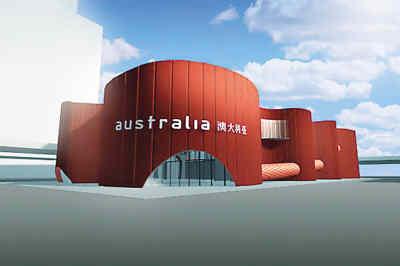Australian Pavilion to demonstrate history and culture of aborigines
2010-02-08 14:51 BJTSpecial Report: 2010 Shanghai Expo Countdown |
The Australian Pavilion at the 2010 Shanghai World Expo is composed of three exhibition areas with different styles: the "journey area," "exploration area" and "enjoyment area." The other day, newspaper reporters followed Lyndall Sachs, commissioner general for the Australian Pavilion, on a visit to the pavilion. Marina, who is from Maningrida, a town in northern Australia, was personally painting on cloth for an exhibit called the "bedrock." The exhibit presents the roots of Australia– the history and culture of the local aboriginal residents.
 |
|
Australian Pavilion |
Traditional life in an aboriginal town
Walking into the "journey area," the visitors will unconsciously be brought into a primitive tribe by the rock paintings on the wall. Looking up, they can see some knitted creatures living in water "traveling freely" overhead. In addition, there are 38 animals that live in the cave and can travel between the rocks, passing by visitors.
This is Australian "dream age." The name of the town, Maningrida, means the "dream age" and the development of the land in the aboriginal language. The other day, the first exhibition area, "dream age," has taken a rough shape.
Maningrada Town is located in the northeastern part of the Arnhem region and is 500 kilometers east of Darwin City. People in the town live a traditional life. The "journey area" will show the religion and life of the Australian aboriginal residents through the families and tribes in the town.
Black-skinned Marina was born in Maningrada Town and into a family that has manufactured handicrafts for generations. The entire family lives on the manufacture of handicrafts and their daily food usually consists of potatoes and fish from the river or sea, overall their lifestyle is very traditional.
Marina has five sisters and four brothers. Their father teaches the sisters to knit and paint. Her older sister designed the pavilion's cloth exhibit. Marina is good at knitting insects and animals, and she was the one who knitted the "creatures that live in the water." She also told reporters that in Maningrida Town, every tribe and family has their own creative style and it cannot be duplicated because the process of creation comes from one's own life.
The "bedrock" has four colors: red, yellow, black and white, and consists of three basic geometric figures, which are a wave shape, triangle and circle, respectively. Marina said that these figures signify the flowing of water because her home is near the water.
Marina was blending on three bricks with a Chinese brush made of dry grass. The newspaper reporters learned that these pigments are all natural, with the red coming from red ocher, the black coming from wood charcoal and the yellow and white coming from different color rocks. These raw materials are grinded and mixed with water to be used as pigments.
Thanks to the Chinese construction workers
Lyndall Sachs said that "bedrock" shows the meaning of "welcome to Australia" from multiple angles and reflects the blend of traditional and modern art in Australia, giving visitors an opportunity to appreciate Australia's local culture.
Among the foreign pavilions, the construction of the Australian Pavilion has been furthest along. As the first foreign pavilion to have its foundation completed, the Australian Pavilion was also the first foreign pavilion to successfully finish basic construction last May. Lyndall Sachs expressed her thanks to Chinese construction workers as she led the reporters on their visit.
Editor: Shi Taoyang | Source: CCTV.com
 Mail
Mail Share
Share Print
Print


 Video
Video









 2009 China Central Television. All Rights Reserved
2009 China Central Television. All Rights Reserved